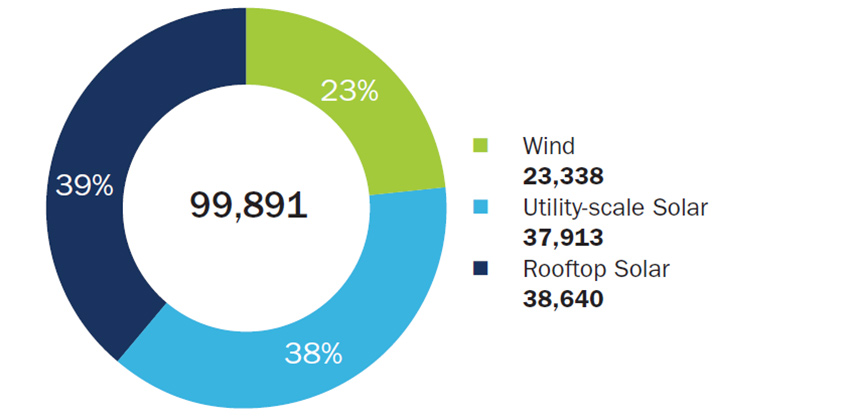Issue Brief
Powering Jobs Growth
with Green Energy
Neeraj Kuldeep, Madhura Joshi, Akanksha Tyagi, Tanmay Bishnoi, Sameer Kwatra, Anjali Jaiswal, Praveen Saxena
July 2019 | Energy Transitions, Sustainable Livelihoods
Suggested Citation: Kuldeep, Neeraj, Madhura Joshi, Akanksha Tyagi, Tanmay Bishnoi, Sameer Kwatra, Anjali Jaiswal, and Praveen Saxena. 2019. Powering Jobs Growth with Green Energy. Council on Energy, Environment and Water, Natural Resources Defense Council, and Skills Council for Green Jobs.
Overview
This issue brief analyses the direct jobs created from solar and wind in India in the last two financial years. It also provides updated findings and recommendations geared toward India’s goal of 175 GW of installed renewable energy (RE) by 2022. Written in collaboration with the Natural Resources Defence Council (NRDC) and the Skills Council for Green Jobs (SCGJ), this brief builds on two earlier issue briefs on clean energy jobs, Greening India’s Workforce (2017) and Clean Energy Powers Local Job Growth in India (2015).
Cumulative Jobs Created in the Solar and Wind Sectors for 65.7 GW of Installed Capacity Until FY19

Source: CEEW-NRDC analysis 2019
Key Findings
- India’s renewable energy workforce has grown five-fold in the past five years. In 2019, nearly 100,000 workers are employed in the solar and wind industry, up from 19,800 workers in 2014.
- The largest RE employment growth occurred in FY18 with over 30,000 new workers in utility-scale solar, rooftop solar, and wind energy.
- Rooftop solar and other decentralised RE technologies are more labour intensive than utility-scale solar and wind energy in India. Nearly 38,640 workers were employed for just 3.8 GW of cumulative installed rooftop solar until FY19. In comparison, 26.2 GW of utility-scale solar employed 37,910 workers and 35.6 GW of cumulative wind energy installed employed 23,340 workers until FY19.
- Low capacity additions compared to the preceding years meant only 12,382 new workers were employed in the RE sector in FY19. There was a 30 per cent decrease in capacity additions in utility-scale solar in FY19 compared to FY18. The capacity addition of rooftop solar grew by only 27 per cent in FY19 compared to 128 per cent in FY18.
- Training programs by SCGJ alone trained over 58,000 workers between FY16 and FY19, demonstrating that training centres in smaller towns and rural areas can help develop the skills needed in the local workforce and help expand the renewable energy market across India.
Key Recommendations
- Strengthen support for decentralised renewable energy projects such as rooftop solar, which have a higher job creation potential.
- Expand government programs and market investment to ensure steady renewable energy growth to support clean energy job creation.
- Support local training centers to boost skill development, particularly in rural areas.
- Increase reporting of employment generation from RE companies.
- Promote the domestic solar manufacturing industry as it can generate an additional 45,000 jobs if the target of 100 GW solar capacity by 2022 is met.
Stronger government programs and market investments are needed to meet India’s clean energy targets of 175 GW and employment potential of over 330,000 workers by 2022, especially given the recent market slowdown in FY19.







